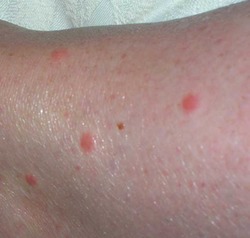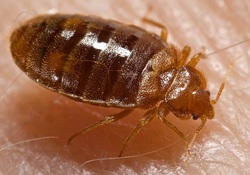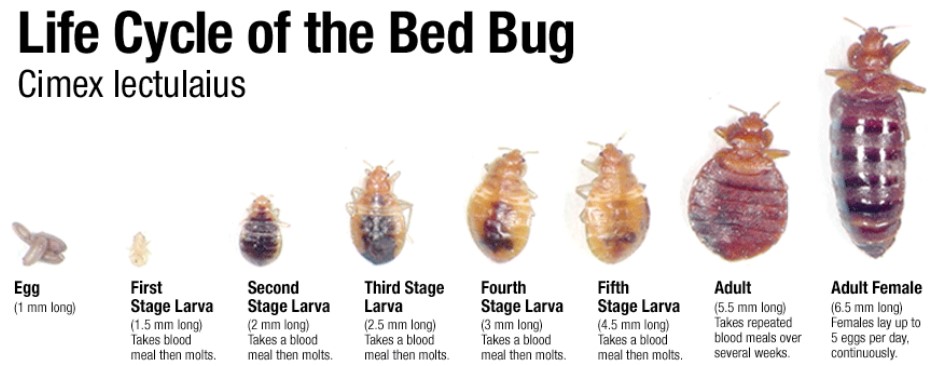Bed Bugs
Your child is required to stay home.
We can discuss your child's return to daycare once all the following criteria has been met:
If your child or you brings bed bugs into the daycare and the daycare has to hire a professional to have them removed, you are responsible for all cost of the professional removal of the bed bugs. If your child brings in bed bugs more than once, the daycare has the right to terminate care.
- Your home has been treated for bed bugs
- All bed bugs are dead
- Your child's clothing is free of bed bugs
If your child or you brings bed bugs into the daycare and the daycare has to hire a professional to have them removed, you are responsible for all cost of the professional removal of the bed bugs. If your child brings in bed bugs more than once, the daycare has the right to terminate care.
|
What are bed bugs?
Bed bugs are brown, flat, oval-shaped insects without wings. They are about the size of an apple seed and they feed on blood. Though bed bugs prefer human blood, they also bite other mammals and birds. After feeding, bed bugs swell up and turn dark red. Being nocturnal insects, they normally bite people at night while they are sleeping. Bed bugs do not normally stay on people. After feeding, they usually return to their hiding places (ex: on or around mattresses, box springs and couches). |

What do bed bug bites look like?
Bed bug bites look like red bumps or rashes on the skin.
They are usually found around the face, neck, upper body, arms and hands. Bed bug bites do not normally have a red spot in the centre.
The bites may appear as unexplained bite marks, as people often do not remember being bitten.
Bed bug bites look like red bumps or rashes on the skin.
They are usually found around the face, neck, upper body, arms and hands. Bed bug bites do not normally have a red spot in the centre.
The bites may appear as unexplained bite marks, as people often do not remember being bitten.
How do bed bugs affect my health?
There is no evidence that bed bugs spread disease; however, people can have allergic reactions to bed bug bites. Repeated scratching at bite marks or scabs may cause secondary skin infections.
Health Canada considers bed bugs a “nuisance pest.” Under The Public Health Act, bed bugs do not have to be reported.
There is no evidence that bed bugs spread disease; however, people can have allergic reactions to bed bug bites. Repeated scratching at bite marks or scabs may cause secondary skin infections.
Health Canada considers bed bugs a “nuisance pest.” Under The Public Health Act, bed bugs do not have to be reported.
What are other effects of bed bugs?
There can be a social stigma connected with having bed bugs. As a result, people who have severe or repeated infestations may feel anxious, worried or ashamed. Some people may have problems with their sleep, mental health, social or family life and finances, and may feel ridiculed or singled out by others.
There can be a social stigma connected with having bed bugs. As a result, people who have severe or repeated infestations may feel anxious, worried or ashamed. Some people may have problems with their sleep, mental health, social or family life and finances, and may feel ridiculed or singled out by others.
Where are bed bugs found?
Bed bugs are usually found in areas where people sleep, or sit, for long periods of time. Bed bugs prefer an environment where they can hide during the day and feed on a sleeping person at night. Although they prefer dimly lit or dark rooms, bed bugs may come into lighted areas to feed. Bed bugs prefer fabric, wood and paper surfaces. They are often found in folds or seams of mattresses and box springs, in or behind headboards and bed frames, behind baseboards, under area rugs, along edges of carpeting and under, or in folds of, chairs and couches.
Bed bugs are usually found in areas where people sleep, or sit, for long periods of time. Bed bugs prefer an environment where they can hide during the day and feed on a sleeping person at night. Although they prefer dimly lit or dark rooms, bed bugs may come into lighted areas to feed. Bed bugs prefer fabric, wood and paper surfaces. They are often found in folds or seams of mattresses and box springs, in or behind headboards and bed frames, behind baseboards, under area rugs, along edges of carpeting and under, or in folds of, chairs and couches.
How do bed bugs travel?
Bed bugs can travel on clothing, blankets, lunchboxes, stuffed toys, or other items that are moved from one place to another (ex: between a child’s home and the daycare). Items that most often have bed bugs are mattresses, box springs, couches and upholstered chairs. However, bed bugs can also be found on a variety of other items, including electronics, books and picture frames.
If bed bugs are not properly treated at the source, there is a risk of carrying the pests into the daycare. Early detection and treatment are the best ways to contain the spread of bed bugs.
Bed bugs can travel on clothing, blankets, lunchboxes, stuffed toys, or other items that are moved from one place to another (ex: between a child’s home and the daycare). Items that most often have bed bugs are mattresses, box springs, couches and upholstered chairs. However, bed bugs can also be found on a variety of other items, including electronics, books and picture frames.
If bed bugs are not properly treated at the source, there is a risk of carrying the pests into the daycare. Early detection and treatment are the best ways to contain the spread of bed bugs.
The length of time your child is required to remain home will depend
on how long it take you to remove the bed bugs from your home.
on how long it take you to remove the bed bugs from your home.

